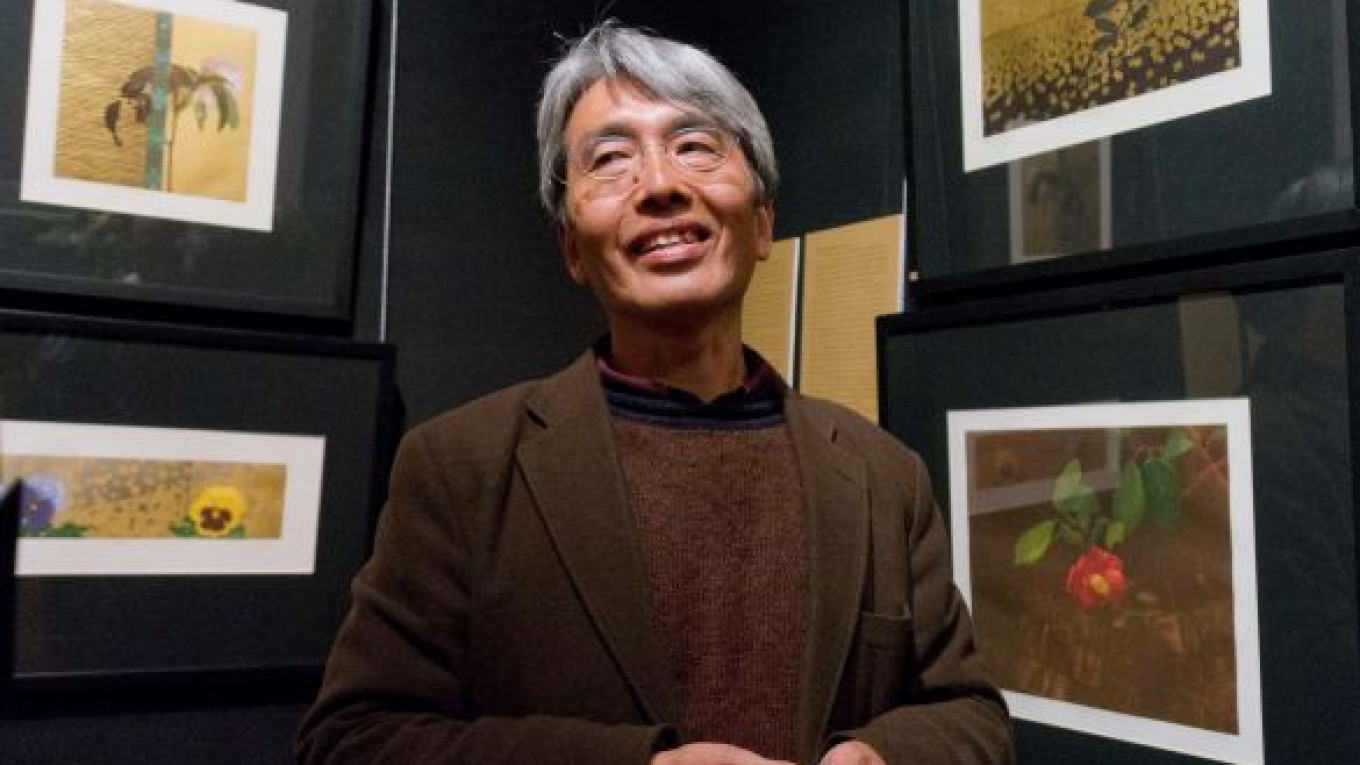The Oriental Museum opened a solo exhibition of Japanese artist Hiroaki Miyayama with an expansive series of graphic interpretations of one of the canonical novels of Japanese literature, "Genji Monogotari," or "The Tale of Genji."
The austere spaces of the Empire-style building of the Lunin House built by famous architect Domenico Gilardi in early 19th century looked even more refined when filled with deep colors on black and golden backgrounds. Miyayama's prints are all non-standard in format, elongated or narrowed, and recall traditional Japanese paintings on silk screens. The artist chooses flowers, plants, leaves and parts of the human body to depict scenes from "The Tale of Genji," a classical work of Japanese literature written by Murasaki Shikibu in the early 11th century around the peak of the Heian period.
"I have chosen to work on the Genji Monogotari series as the story is very important for Japanese art," Miyayama told The Moscow Times at the exhibit's opening ceremony. "There have been many expressions and interpretations of the story over the years. I tried to challenge it, and it gave me much inspiration."
Traditional wooden prints of the 18th and 19th century usually displayed fragments of Genji Monogotari as crowded and delicate scenes of court life: Long-haired beauties in luxurious kimonos are busy with their morning routine while being spied on by their lovers outside the palace. The intensity and delicacy of Miyayama's prints is hidden in the fragmentary nature of the images. Whether the illustration for a particular chapter is a plant or a man's fist, it fits into a cropped format to make an impression of a fragment of a wider composition. Everything else on the golden print stays invisible and may be drawn by the spectator's imagination.
"At the beginning, I was a contemporary artist, and I used to make installations. Then I started to appeal more to traditional forms. I found that the leaf itself is beautiful, and a flower is even more beautiful. But it's only a sign for time or any other idea," Hiroaki Miyayama said.
Ever since the Meiji Restoration in the second half of the 19th century opened the borders for European influences and foreign affairs, Japanese art has been divided into two schools — Japanese-style painting and European-style painting. With the dissemination of the international language of contemporary art, the schools were finally mixed into an impulse that gave rise of all popular trends of Japanese design and pop culture after the 1980s.
Miyayama is someone who consciously searches for methods of representation within the traditional language, even when you see traces of postmodern hyper-realism in the way he creates his symbolic images in a fully European technique of colored aquatint prints. The exhibition results in a truly peaceful and mediative state of mind — with the help of the rooms of the Oriental Museum of Moscow.
The exhibition is completed by ikebana installations of Ikenobo school.The Museum of Oriental Art has been undergoing extensive repairs for most of the past year, yet will soon re-open in full.
“The Images of Genji Monogotari by Hiroaki Miyayama” runs from Nov. 16 to Dec. 8 at the State Museum of Oriental Art, 12a Nikitsky Bulvar, +7 495-691-0212, orientmuseum.ru.
Contact the author at [email protected]
A Message from The Moscow Times:
Dear readers,
We are facing unprecedented challenges. Russia's Prosecutor General's Office has designated The Moscow Times as an "undesirable" organization, criminalizing our work and putting our staff at risk of prosecution. This follows our earlier unjust labeling as a "foreign agent."
These actions are direct attempts to silence independent journalism in Russia. The authorities claim our work "discredits the decisions of the Russian leadership." We see things differently: we strive to provide accurate, unbiased reporting on Russia.
We, the journalists of The Moscow Times, refuse to be silenced. But to continue our work, we need your help.
Your support, no matter how small, makes a world of difference. If you can, please support us monthly starting from just $2. It's quick to set up, and every contribution makes a significant impact.
By supporting The Moscow Times, you're defending open, independent journalism in the face of repression. Thank you for standing with us.
Remind me later.






